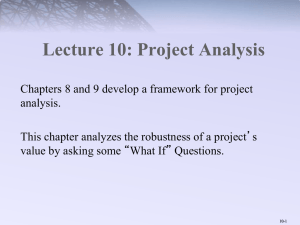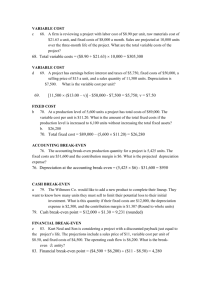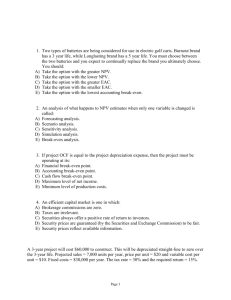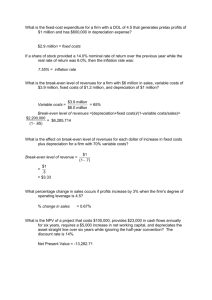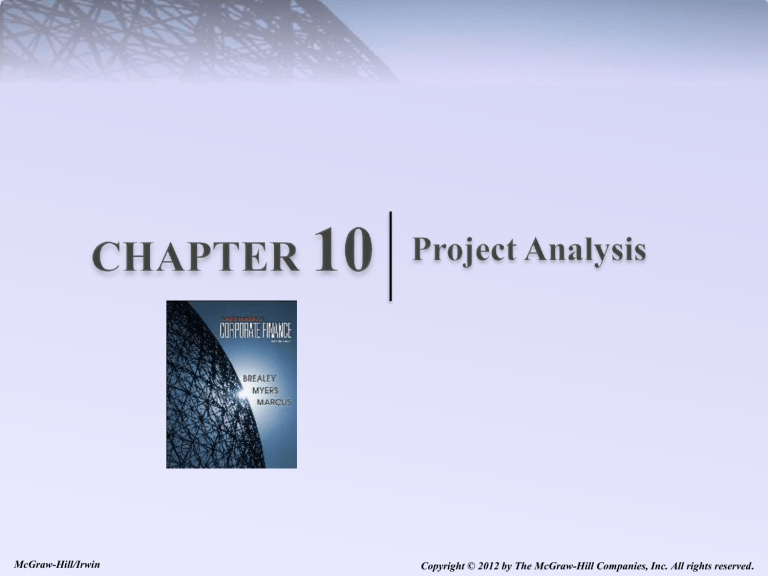
McGraw-Hill/Irwin
Copyright © 2012 by The McGraw-Hill Companies, Inc. All rights reserved.
Project Analysis
Chapters 8 and 9 develop a framework for project
analysis.
This chapter analyzes the robustness of a project’s
value by asking some “What If” Questions.
10-2
Capital Budget
Capital Budget – A list of planned investment
projects.
10-3
Capital Budgeting:
The Decision Process
1. Stage 1: The Capital Budget
2. Stage 2: Project Authorization
•
•
•
•
Outlays required by law or company policy
Maintenance or cost reduction
Capacity expansion in existing business
Investment for new products
10-4
Potential Capital Budgeting
Problems
Ensuring forecasts are consistent
Eliminating conflicts of interest
Reducing forecast bias
Proper selection criteria (NPV and others)
10-5
What-if Testing
Sensitivity Analysis - Analysis of the effects on
project profitability of changes in sales, costs, etc.
Scenario Analysis – Analysis given a particular
combination of assumptions.
Simulation Analysis - Estimation of the
probabilities of different possible outcomes.
Break-Even Analysis - Analysis of the level of
sales at which the company breaks even.
10-6
Sensitivity Analysis
Analysis of the effects on project profitability of
changes in sales, costs, etc.
Why is sensitivity analysis useful?
10-7
Sensitivity Analysis - Example
Base Case: Expected cash flows from a new project (with 8% Opportunity Cost of Capital; 40%
average tax rate; variable costs are a constant 80% of sales; all numbers in $000s)
Year 0
Investment
Years 1-12
Calculate:
-5,400
Sales
16,000
Variable Costs
(12,800)
Fixed Costs
(2,000)
Depreciation
(450)
Pretax profit
750
Taxes
(300)
Profit after tax
450
Operating cash flow
900
Net Cash Flow
-5,400
NPV = $1,382.47
IRR = 12.7%
Payback Period = 6 years
Profitability Index = .256
900
10-8
Sensitivity Analysis - Example
Possible Range of Variables
Range
Variable
Pessimistic Expected
Optimistic
Sales
14,000
16,000
18,000
Fixed Costs
2,500
2,000
1,500
10-9
Sensitivity Analysis: Changing Sales
(with 8% Opportunity Cost of Capital; 40% average tax rate; variable costs are a
constant 80% of sales; all numbers in $000s)
Pessimistic Case—Sales = $14,000
Pessimistic Case
Year 0 Years 1-12
Optimistic Case—Sales = $18,000
Optimistic Case
Year 0
Years 1-12
Investment
Investment
-5,400
Sales
14,000
Variable Costs
-5,400
Sales
18,000
Variable Costs
Fixed Costs
(2,000)
Depreciation
(450)
Fixed Costs
(2,000)
Depreciation
Pretax profit
Pretax profit
Taxes
Taxes
Profit after tax
Profit after tax
Operating cash flow
Operating cash flow
Net Cash Flow
-5,400
NPV = -$426
Net Cash Flow
(450)
-5,400
NPV = $3,191
10-10
Sensitivity Analysis: Changing Fixed Costs
(with 8% Opportunity Cost of Capital; 40% average tax rate; variable costs are a
constant 80% of sales; all numbers in $000s)
Pessimistic Case—Fixed Costs = $2,500
Pessimistic Case
Year 0 Years 1-12
Optimistic Case—Fixed Costs = $1,500
Optimistic Case
Year 0 Years 1-12
Investment
Investment
-5,400
Sales
16,000
Variable Costs
(12,800)
Fixed Costs
-5,400
Sales
16,000
Variable Costs
(12,800)
Fixed Costs
Depreciation
(450)
Depreciation
Pretax profit
Pretax profit
Taxes
Taxes
Profit after tax
Profit after tax
Operating cash flow
Operating cash flow
Net Cash Flow
-5,400
NPV = -$878
Net Cash Flow
(450)
-5,400
NPV = $3,643
10-11
Limits to Sensitivity Analysis
• Ambiguous
• How do you consistently define “optimistic” or
“pessimistic”?
• Interrelatedness of variables
10-12
Scenario Analysis
Scenario Analysis – Project analysis given a particular
combination of assumptions.
Why is it useful?
Simulation Analysis – Estimation of the probabilities of
different possible outcomes, e.g., from an investment project.
Why is it useful?
10-13
Scenario Analysis: Introducing Competition
Assume that it will take two years for competition to enter the market. At this time,
sales drop 10% and variable costs increase to 82% (increased labor demand). What
happens to NPV under this scenario?
Base Case – No Competition
Year 0 Years 1-12
Investment
-5,400
Sales
16,000
Variable Costs
(12,800)
Fixed Costs
(2,000)
Depreciation
(450)
Pretax profit
750
Taxes
(300)
Profit after tax
450
Operating cash flow
900
Net Cash Flow
-5,400
900
NPV = $1,382
Scenario – Introduce Competition
Year 0 Years 1-2 Years 3-12
-5,400
Investment
16,000
Sales
14,400
(12,800)
Variable Costs
(2,000)
(2,000)
Fixed Costs
(450)
(450)
Depreciation
750
Pretax profit
(300)
Taxes
450
Profit after tax
900
Operating cash flow
900
-5,400
Net Cash Flow
NPV = -$717
10-14
Break-Even Analysis
Break-Even Analysis - Analysis of the level of sales
at which the project breaks even.
Why is this useful?
10-15
Break-Even Analysis – Example
(with 8% Opportunity Cost of Capital; 40% average tax rate; variable
costs are a constant 80% of sales; all numbers in $000s)
Year 0 Years 1-12
X Number of Units Sold
Investment
$5,400
Sales
45 X
Var. Cost
(36 X )
Fixed Costs
(2, 000)
-Suppose each unit has a price
point of $45,000
Depreciation
(450)
Pretax Profit
9 X 2, 450
-All other variables are at their
base case levels
Taxes (40%)
3.6 X 980
Net Profit
5.4 X 1, 470
Net Cash Flow -5,400
5.4 X 1, 020
-Determine the number of units
that must be sold in order to break
even, on an NPV basis.
10-16
Break-Even Point: Accounting
Break-Even Point (Accounting) - The break-even point is the number of units
sold where net profits = $0.
0 5.4 X 1, 470
1, 470
X
273 Units
5.4
What does the accounting break-even point not account for?
Note: Accounting Break-Even can be expressed in terms of revenue:
Break-Even level of revenues =
fixed costs + depreciation
additional profit from each additional dollar of sales
10-17
Break-Even Point: Finance
NPV Break-Even Point (Finance):
How can we find the present value of future cash flows? As long as cash
flows are equal each year, we can use the Annuity Factor.
Step 1: PV (Cash Flows) = Annuity Factor Yearly Cash Flows
1- (1 r ) t
where Annuity Factor =
r
1 (1 .08)12
Example: PV(Cash Flows) =
[5.4 X 1, 020]
.08
10-18
Break-Even Analysis
Recall: the break-even point is the number of units sold where NPV = $0.
Step 2: PV (Cash Flows) = Initial Investment
1 (1 .08)12
Example [5.4 X 1,020] 5, 400
.08
X 322 units
10-19
Operating Leverage
Operating Leverage - Degree to which costs are fixed.
Degree of Operating Leverage (DOL) - Percentage
change in profits given a 1% change in sales.
DOL
percent change in profits (pre-tax)
percent change in sales
1
fixed costs
profits
10-20
Operating Leverage:
Why is it useful?
10-21
Degree of Operating Leverage:
Example
Base Case
Year 0
Investment
-5,400
Sales
Years 1-12
16,000
Variable Costs
(12,800)
Fixed Costs
(2,000)
Optimisic Sales
Year 0
Investment
-5,400
Sales
Depreciation
Pretax profit
750
Pretax profit
(300)
450
Profit after tax
Operating cash flow
900
Operating cash flow
900
Net Cash Flow
-5,400
(2,000)
(450)
1,150
Taxes
Profit after tax
Net Cash Flow
(14,400)
Fixed Costs
(450)
Taxes
18,000
Variable Costs
Depreciation
Years 1-12
(460)
690
1,140
-5,400
1,140
New Old 1,150 750
.5333
Old
750
18, 000 16, 000
% Change in Sales =
.1250
16, 000
% Change in Profits .5333
DOL =
4.27
% Change in Sales .1250
% Change in Profits =
10-22
Real Options
1.
Option to expand
2.
Option to abandon
3.
Timing option
4.
Flexible production facilities
10-23
Real Options & the Value of
Flexibility
Decision Trees – Diagram of sequential decisions and
possible outcomes.
Decision trees help companies determine their options by
showing various choices and outcomes.
The option to avoid a loss or produce extra profit has value.
The ability to create an option has value that can be bought or
sold.
10-24
Decision Trees: Example
Success
Test New Product
(Invest $200,000)
Pursue project
NPV=$2million
Failure
Stop project
NPV=0
Don’t Test New
Product
NPV=0
10-25


